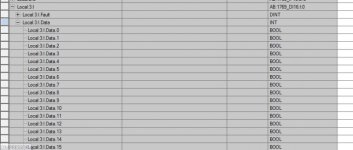chandrapaul
Member
hi,
i know how to write program in rslogix 500. in youtube video of rslogix 5000 programming i saw that they are just writing character tags (like start,stop,motor...) for input and output commands. there they dont assigning any input output address like I:0/0,O:0/0 like rslogix 500.
my question is if they are not assigning any I/O address in rslogix 5000 then how to know that which tags are correspond to which I/O port of the PLC?
thanks
i know how to write program in rslogix 500. in youtube video of rslogix 5000 programming i saw that they are just writing character tags (like start,stop,motor...) for input and output commands. there they dont assigning any input output address like I:0/0,O:0/0 like rslogix 500.
my question is if they are not assigning any I/O address in rslogix 5000 then how to know that which tags are correspond to which I/O port of the PLC?
thanks




